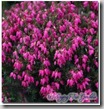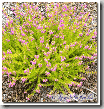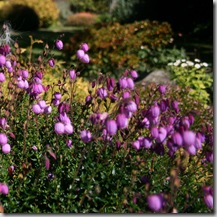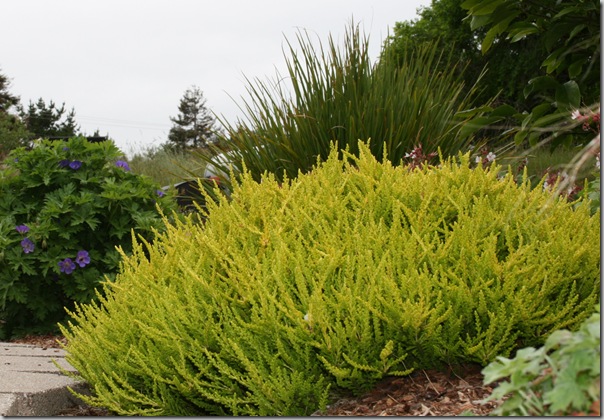I first heard about the heather plant when I was 10, reading an old-fashioned British book about a group of children who escaped their abusive guardians and made a home together on a secret island. They built a willow house out of live willow stems, so their home grew lush and protected, and they used heather to make their beds soft and cushy.
(Can I step onto my children’s lit soapbox for a second, and say that any American parents who haven’t yet read Enid Blyton with their kids should rush right out and do so? She seems to understand how children feel and what they want in a book better than any other author I’ve read.)
So anyway, even before I knew anything about plants, I had a vision of what heathers were like – growing in gorgeous flowering expanses, and with a soft, pleasing texture. I was glad when I got into horticulture school and saw my first photo of a large heather garden – it was exactly what I’d imagined all those years ago in my book!
Heathers have become a favorite of mine now, because they’re low-maintenance, deer-resistant, most are winter-hardy, they’ll take wind and seacoast wind with no problem, they look great in containers, can tolerate low-water conditions in the ground once mature, and if you plan things right, you can have blooms year-round on evergreen plants with great foliage. All you need is decent drainage and some sunshine to do well with them.
I want to give you a rundown of some of the most common types of heath and heather and how they differ. They’re such fantastic plants, and I run into a lot of confusion when talking with would-be heather enthusiasts about which kind does what.
First – is it heath or heather?
When people refer to heathers, they’re usually talking about one of three types of plant – Calluna (Scotch Heather), Daboecia (Irish Heath), and Erica (Heath and Winter Heath). But most people just refer to all three kinds of plant as heathers, because to do otherwise takes unnecessary studying and is kind of geeky (pause for some innocent-sounding whistling).
Still, the three kinds of heather have very different uses and attributes, so even if you call them all heathers, you’ll want to have some idea of which type you’re after. It’d be rather disappointing to plant a heather for winter flowers and find you’d gotten confused and planted a summer-bloomer!
So how are the three kinds different? Which ones do I want?
Erica/ Heath (has summer and winter-blooming types):
 Erica has the finest texture of all the heathers, and generally feels soft and fluffy. If you want winter flowers, check into some varieties of Erica darleyensis or Erica carnea , which can take you from November through May if you select your varieties carefully for continuous bloom.
Erica has the finest texture of all the heathers, and generally feels soft and fluffy. If you want winter flowers, check into some varieties of Erica darleyensis or Erica carnea , which can take you from November through May if you select your varieties carefully for continuous bloom.
 There are also some Bright! Pink! Fluffy! summer-blooming heathers that are like the Britney Spears of the heather world (well, before the drug addiction and all of that. Hmpht. Moving on!). The other summer-blooming heathers have a slightly stiffer habit and a gentle feeling of dignity to them, while these are just cheerful, soft, and did I mention the flowers are Bright! Pink! And magenta!! Look into Erica cinerea if you find the summer-blooming Callunas too stiff for your taste, or just want that exuberant splash of color.
There are also some Bright! Pink! Fluffy! summer-blooming heathers that are like the Britney Spears of the heather world (well, before the drug addiction and all of that. Hmpht. Moving on!). The other summer-blooming heathers have a slightly stiffer habit and a gentle feeling of dignity to them, while these are just cheerful, soft, and did I mention the flowers are Bright! Pink! And magenta!! Look into Erica cinerea if you find the summer-blooming Callunas too stiff for your taste, or just want that exuberant splash of color.
Daboecia/ Irish Heath (big flowers, blooms spring through fall, tolerant of part shade):
 Daboecia (pronounced duh-bee-shuh) are the easiest to slip into any type of garden design. Their foliage is a rich green color, they have a neat habit that walks the line between stiff and fluffy, and the flowers come in colors of lavender, magenta, and white that harmonize well with other plants’ colors.
Daboecia (pronounced duh-bee-shuh) are the easiest to slip into any type of garden design. Their foliage is a rich green color, they have a neat habit that walks the line between stiff and fluffy, and the flowers come in colors of lavender, magenta, and white that harmonize well with other plants’ colors.
Plus, they’re happy in part shade AND full sun, so they work perfectly in those areas where you are transitioning from shade-lovers to sun-lovers.
The deep green of the foliage and the large bell-shaped flowers (well, large for a heather!) look great in woodland settings, near water features, in a flower garden where you need some evergreen structure or longer-lasting flowers – I’ve even seen them looking beautifully at home in a Japanese-style garden – sheared every year to take on a neat shape. They bloom spring through late fall so can carry the garden through some dull, no-flower patches.
Calluna/ Scotch Heather (late summer to fall bloomer, some varieties have fancypants new growth or vibrant winter foliage color):
Callunas are the big guns of the heather world, and there is the most variety here for playing with foliage color and plant shape. There are flat 2” tall groundcovers, teensy little bun-shaped ones for rock gardens or troughs, wild spreading ones with tangling, tumbling stems, and neat, upright-growing spreaders.
Then the foliage colors – flaming red new growth in spring, creamy-white new growth in spring, gold or silver and every shade of green, and vivid red or cinnamon-bronze in winter…
There is plenty of room to screw up your foliage combinations with all the varieties available, but if you take the time to set different combinations of heather next to one another and see how it all looks – there’s the most potential for creating stunning and unusual combinations, too.
These guys bloom in that dead period at the end of summer and early fall when so many of your summer perennials have paused in their flowering. If you’re planting for blooms, I’d tend to avoid the red and bronze ones as they’ve been bred more for foliage, and besides, pale pink blooms on red foliage is kind of not hot. If I’m in a bad mood, that color combo really offends me and I’ll sometimes just cut the flowers off.
My favorites are the green ones with white/cream new growth in spring and white flowers in fall (talk about a multi-season plant! Look for ‘Spring Cream’, ‘Japanese White’, or ‘Ruby Slinger’), the silvery-grey ones that make such a striking companion for the darker greens of other heathers (‘Velvet Fascination’), and the insane flaming ones with gold foliage that go red-tipped in winter.
If you want to learn more about heathers and how to garden with them, check out these resources:
Gardening with Hardy Heathers by Small and Wulff (a fantastic book with everything you need to know to design, propagate, and generally get geeky with the heather world)
The International Heather Society’s online heather encyclopedia
Video on how to prune heaths and heathers
Fall-blooming heathers for autumn color
Small plants for winter color (some winter-interest heather suggestions)
Photo credit: both photos of Erica plants courtesy of Singing Tree Gardens Nursery


26 responses to “Callunas, Ericas, Daboecias, Oh My! Demystifying the Different Kinds of Heather”
Gen, Great post. I have been a fan of Heaths and Heathers for a long time, but haven’t used them in a long time. Thanks for the great links too! We have several nurseries in the region that grow Heaths and Heathers, and it’s about time I revisited them and reacquainted myself with this wonderful group of plants. Thanks for the inspiration!
Thanks, Scott! I’m glad to hear heathers do well in Connecticut, too. I think they’re well worth growing – so much variety and good for so many difficult spots.
I’ve never grown heather, nor did I know much about them. I’ll have to do some research for what might stand the best chance in my zone 5 garden and add one!
Gen,
I love heaths and heathers too but they just don’t seem to like it in my garden. I bought a mix of them a few years ago and planted them in almost-full sun in a rocky bed and they’ve never shined like I had images of them doing. The deer definitely leave them alone, which is wonderful, but they just don’t seem to flower well. I think I’ll go clicking around in your links and see if I can find out why.
Huh! That’s really unfortunate. They love acid soil, so I fertilize them in spring, then a light dose in fall with an organic fert for acid-loving plants. They definitely perform best when sheared lightly after bloom, but if you aren’t getting any blooms – well – what in the world?
I’m about to post a link to a free ebook from the heather society on how to care for them, so keep an eye out for that, Debbie. That might have some insight for you…
[…] Heathers and heaths: the three kinds and how to use them […]
[…] Heather and Heath: Which Heather to Choose […]
[…] Heathers and Heaths: Tough Plants for Your Seacoast Garden […]
[…] Second row, from left: Cistus purpureus/ Orchid Rock Rose, Ceanothus griseus ‘Diamond Heights’/ Variegated Carmel Creeper, Calluna vulgaris ‘Velvet Fascination’ and ‘Dark Beauty’/ Scotch Heather […]
This information is really helpful. Thanks to all of you!!!
Hi Genevieve! Love the name (its my daughters, and we also live next to Ste. Genevieve, Missouri). I’m such a heath and heather fan. I am also a landscape designer in Missorui and was curious if you know of a nursery that has a large cultivar wholesale selection . I can spend hours on heathsandheathers picking out varieties! These plants are so underused! Love them!
Thanks!
Hi Jaime, I sure wish I did! The best I can do is refer you to Singing Tree Gardens, a local place that sells retail by mail order. They have some varieties but their specialty isn’t heathers, it’s Rhododendrons. If you find a better resource, I’d be delighted and grateful if you’d post it!
I want a heather that can withstand heavy snow and -20F. Do you know of any? I live in a ski town 40 miles S of Anchorage at sea level and have a rock garden and part daylight.
I don’t garden in those conditions. Perhaps the book on heathers I recommended could provide insight?
Any heather. Hardy to zone 2-3????
I garden in zone 9. Try looking at the Cold Climate Gardener website and see what plants she recommends?
Dear Genevieve,
My husband and I are currently visiting Scotland and were wondering about the difference between heather and heath. One hotel fellow said heath only meant barren, open land with low shrubs. So I was delighted to find your blog. Thank you for so delightfully delineating the differences. I will look up your author suggestion (thanks). Do you think heathers would grow in Georgia, USA?
Eda
Hi Eda, thanks for your sweet comment! I have no idea what grows in Georgia, having never visited, but it’s probable the Garden Web forums for your region could answer that question. If you try them there, let me know how they do! -Gen
I will sheepishly admit that I did not know there were three different varieties of heather, though my name is Heather and I am quite fond of my namesake! You learn something new every day! I hope you don’t mind but I’d like to link to this blog post on my Squidoo page. Hope that is okay! Cheers. Heather
Thanks for your informative post on heather, which I just got to “winterize” my summer garden. I got a bright pink species probably in the third category, although I’ll check the scientific name to confirm. Here’s a question:
This heather reminds me of our summer Veronica Speedwell plant and flowers. Do you know if they are related?
Hah! No clue whether they’re related, but I suspect not. But they certainly go well, design wise, don’t they? 🙂
[…] North Coast gardening has two nice posts on heathers, here and here. […]
[…] sometimes called “heath” (if you would like to know the difference between heather and heath, Genevieve at North Coast Gardening describes it well). They provide year-round color from white, red, pink, and purple flowers, and […]
I have recently become interested in heathers, from reading a book written and based in Scotland. I am wondering if heathers grow in Virginia in zone 7a which is where I live.
Thank you!
I am writing to inquire as when is the best time and how to propagate heather plants? I live in the PNW, near the Puget Sound. Thank you Maryae
[…] You might also enjoy my video post on How to Prune Your Scotch (and other) Heathers, or this article about the three different kinds of heather and when to use each. […]